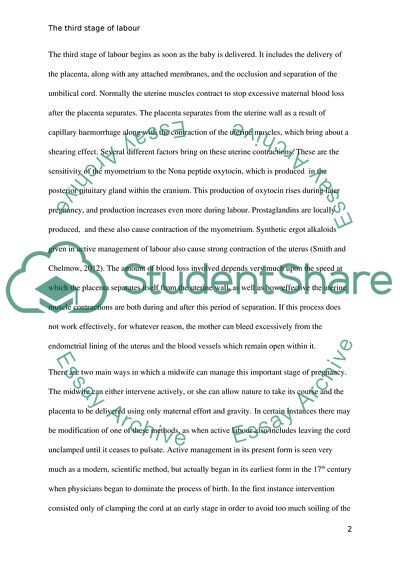
- Home
- Free Samples
- Premium Essays
- Editing Services
- Extra Tools
- Essay Writing Help
- About Us
- Studentshare
- Subjects
- Health Sciences & Medicine
- Midwifery: Active Management vs Physiological Management of the Third Stage of Labour
Midwifery: Active Management vs Physiological Management of the Third Stage of Labour - Literature review Example

- Subject: Health Sciences & Medicine
- Type: Literature review
- Level: Undergraduate
- Pages: 25 (6250 words)
- Downloads: 0
- Author: jadynkoss
Extract of sample "Midwifery: Active Management vs Physiological Management of the Third Stage of Labour"
It considers human obstetric physiology, and possible interventions, and also takes into consideration the wishes of the mother involved, as well as the requirements for adequate staff cover and training. The third stage of labour begins as soon as the baby is delivered. It includes the delivery of the placenta, along with any attached membranes, and the occlusion and separation of the umbilical cord. Normally the uterine muscles contract to stop excessive maternal blood loss after the placenta separates. The placenta separates from the uterine wall as a result of capillary haemorrhage along with the contraction of the uterine muscles, which brings about a shearing effect. Several different factors bring on these uterine contractions.
These are the sensitivity of the myometrium to the Nona peptide oxytocin, which is produced in the posterior pituitary gland within the cranium. This production of oxytocin rises during later pregnancy, and production increases even more during labour. Prostaglandins are locally produced, and these also cause the contraction of the myometrium. Synthetic ergot alkaloids given in the active management of labour also cause strong contraction of the uterus (Smith and Chelmow, 2012). The amount of blood loss involved depends very much upon the speed at which the placenta separates itself from the uterine wall, as well as how effective the uterine muscle contractions are both during and after this period of separation.
If this process does not work effectively, for whatever reason, the mother can bleed excessively from the endometrial lining of the uterus and the blood vessels which remain open within it. There are two main ways in which a midwife can manage this important stage of pregnancy. The midwife can either intervene actively, or she can allow nature to take its course and the placenta to be delivered using only maternal effort and gravity. In certain instances, there may be a modification of one of these methods, as when active labour also includes leaving the cord unclamped until it ceases to pulsate.
CHECK THESE SAMPLES OF Midwifery: Active Management vs Physiological Management of the Third Stage of Labour
How Normality Can Be Facilitated and Maintained During Childbirth
Reduction in Maternal Mortality from Postpartum Haemorrhage
Antenatal and Intrapartum Competencies
Midwifery: Guidance during a Third Stage Physiological Delivery
The Aspect of Using Water in the First Stage of Labour
Primary Postpartum Hemorrhage
The Effect of Active Management of the Third Stage of Labour on Maternal Morbidity and Mortality
Preparation of an Evidence-Based Clinical Guideline Informed by a Critique of Relevant Evidence

- TERMS & CONDITIONS
- PRIVACY POLICY
- COOKIES POLICY